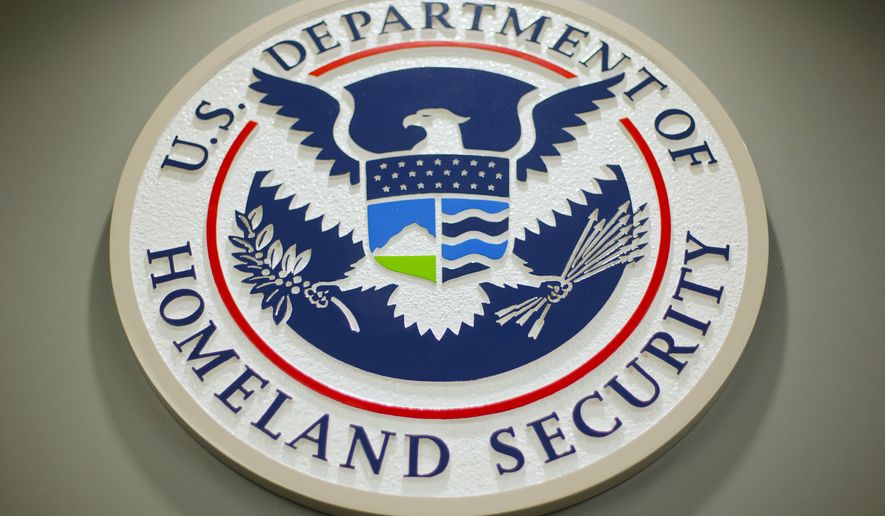The Homeland Security Department failed to fully vet some of the Afghan evacuees it brought into the U.S. during last year’s airlift, the department’s inspector general said in a devastating audit, which warned that some people who “posed a risk to national security” were indeed let into the country.
One evacuee, just liberated from prison by the Taliban, was cleared to reach the U.S. Another reached the U.S. and was released, only to have the FBI conclude three months later that the evacuee “posed national security concerns.”
The evacuation was constructed so hastily that the department wrote procedures on the fly, with screening decisions made “on an ad hoc basis,” said the audit, released Tuesday.
“As a result, DHS paroled at least two individuals into the United States who posed a risk to national security and the safety of local communities and may have admitted or paroled more individuals of concern,” the inspector general concluded.
The prisoner was even flagged upon arrival at a U.S. airport. A Customs and Border Protection passport screener spotted “derogatory” information in the system, but a supervisor overruled the officer and paroled the evacuee, the audit found.
Three weeks later, the FBI re-flagged the evacuee. U.S. Immigration and Customs Enforcement picked up and deported the person.
The report contrasts with the Biden administration’s claims of a smooth operation that thoroughly checked evacuees.
The audit found that people who gave “questionable” names or dates of birth were allowed to enter. U.S. officials just assigned a Jan. 1 birthdate for whatever age the evacuees said they were.
Out of roughly 89,000 names, more than 11,000 were listed as having Jan. 1 birthdates. Another 417 had no known first name, and 242 were listed with no known last name.
That meant they couldn’t be properly run against the government’s databases, raising risks that even more dangerous people were admitted among the Afghan evacuees, the inspector general said.
“Based on the cultural differences and questionable data in the biographic fields, it was challenging for DHS to fully screen and vet the evacuees,” the inspector general said.
Homeland Security vehemently disagreed with the findings. It said the report ignored the department’s reliance on other agencies to help with the vetting.
SEE ALSO: Pompeo warns U.S. less safe one year after Afghanistan withdrawal
“CBP was only one part of an interagency screening and vetting process and did, in fact, screen, vet and inspect all Afghan nationals” at the airport, Jim H. Crumpacker, Homeland Security’s liaison to the inspector general, wrote in the department’s response.
He rejected the inspector general’s two recommendations to develop a better contingency plan for such events and to come up with a “recurrent” vetting process to re-check evacuees.
Mr. Crumpacker insisted evacuees already face recurrent vetting.
He said the fact that the former prisoner was later spotted and deported is proof that the system “works as designed.”
In a follow-up statement, DHS spokesman Angelo Fernandez defended the level of checks Afghans faced, ticking off the agencies involved: “the Departments of Defense, Homeland Security, and State; Federal Bureau of Investigation; National Counterterrorism Center; and other Intelligence Community partners.”
“Afghan nationals who did not clear these checks were not permitted to travel to the United States as part of OAW,” he said.
The problem with that, according to congressional investigators, is the checks themselves, which often used bad information from the Afghans and sometimes didn’t scour the right databases.
Sen. Rob Portman of Ohio, top Republican on the Senate Homeland Security Committee, called the report “very concerning” and urged the Biden administration to reverse course and accept the inspector general’s recommendations.
“I support the resettlement of Afghans who stood in battle with us and our allies over the last 20 years but as we approach the 21st anniversary of 9/11, the United States faces an increased threat due to this administration’s catastrophic evacuation of Afghans without rigorous or thorough vetting,” Mr. Portman said.
The airlift brought Afghans out of Kabul and deposited them at “lily pad” sites in third countries, where American officials were supposed to check their identities and fingerprints through government databases.
If those checks didn’t produce any warning signs, the evacuees were given “green status” and cleared to enter the U.S. without any in-person interviews.
Those who were flagged were given “red status” and were supposed to be blocked from boarding planes until they were investigated and cleared to green status.
Once they arrived in the U.S., they went through the same passport inspection as other foreign arrivals.
As of March, at least 35 evacuees without green status boarded flights, the audit said, and roughly 1,300 were cleared for travel even though their fingerprints hadn’t been run through databases.
Customs and Border Protection insisted that the 35 received “green status” upon arrival at a U.S. airport. That was a later point than intended, but the status was issued before they were released.
The audit said some employees blamed the vetting foul-ups on orders to speed Afghans through the process. The administration promised the other host countries that evacuees would not be staying long.
In Germany, where more than 40,000 evacuees were siphoned through the process, the U.S. promised to vet each one in less than 10 days. In Italy, it was 14 days. Qatar, with more than 10,000 evacuees, was more generous with 30 days.
• Stephen Dinan can be reached at sdinan@washingtontimes.com.




Please read our comment policy before commenting.